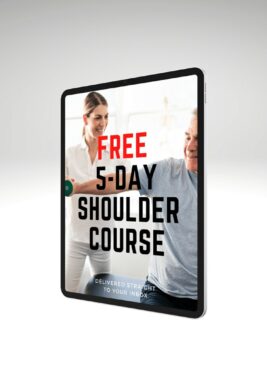Learn
Scapula Strengthening Exercises | Early Shoulder Rehab
As it is unlikely to change someone’s individual pattern of motor control for the scapula, training the muscles of the scapulothoracic joint should aim to ensure that the scapula has the maximum capability of movement through global muscle activation and strength. While training in functionally relevant positions should be emphasized, those positions can be challenging during early postoperative rehab or in acute nonoperative shoulders.
For this reason, Kibler et al. from the year 2008 and have evaluated 4 different exercises that activate key muscles of scapular movement like the upper and lower trapezius and the Serratus anterior.
Here are the exercises:
Number 1: Inferior GlideThe Inferior Glide Exercise is carried out as an isometric exercise with a focus on humeral head depression and scapular retraction. This exercise shows a high EMG activity in the Serratus anterior and lower trapezius muscles.to perform the exercise, have your patient seated upright with the side to be trained in 90° of abduction and the fist clenched on a supportive surface. Then the patient is asked to apply pressure with his fist in the direction of adduction and to inferiorly depress the scapula for 5 seconds.
Number 2: Low Row
This exercise mainly targets the Serratus anterior and lower trapezius while bringing the scapula into external rotation and posterior tilt position. To do the exercise, have the patient stand in front of the treatment bench with the hand of the side to be trained placed on the edge of the bench and his palm facing posteriorly. Then the patient extends his trunk and maximally pushes his hand against the edge of the bench in the direction of shoulder extension while retracting and depressing the scapula for 5 seconds.
Number 3: The Lawnmower
This exercise is a multijoint exercise that uses the motion of hip/trunk extension, trunk rotation and scapular retraction and activates the upper and lower traps and Serratus anterior to the same degree. To perform the exercise, have your patient start with his trunk flexed and rotated to the contralateral side of the side to be exercises so that his hand is at knee height.then he is asked to rotate and extend the trunk towards the side to be trained and to “place his elbow into his back pocket” by a strong contraction of the muscles.
Number 4: Robbery
This is again a multijoint exercise with a focus on scapular retraction that activates the upper and lower traps and Serratus anterior to the same degree.To perform the exercise, start in a standing position with the trunk flexed between 40 and 50 degrees with the arms forward flexed and the palms facing thighs.While keeping the elbows close to the body, move into trunk and arm extension and flex the elbows so that your palms are facing up and away from your body.Again, focus on a strong contraction for 5 seconds while pinching both scapulae towards your back pocket.
TWO MYTHS BUSTED & 3 KNOWLEDGE BOMBS FOR FREE

Like what you’re learning?
BUY THE FULL PHYSIOTUTORS ASSESSMENT BOOK
- 600+ Pages e-Book
- Interactive Content (Direct Video Demonstration, PubMed articles)
- Statistical Values for all Special Tests from the latest research
- Available in 🇬🇧 🇩🇪 🇫🇷 🇪🇸 🇮🇹 🇵🇹 🇹🇷
- And much more!








